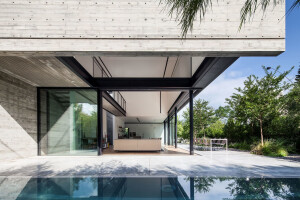The building is divided into two volumes, the aim being to orient the communal living-rooms towards the sea views and to have the building adapt to the form and topography of the site. The volumes are joined together on their northern side, thereby connecting the interior circulations of the house.
Entirely glazed, the south-facing rooms on the upper floor are shielded from the sun and provide a filter for the views via a delicate glazed lattice of ceramic that is separate from the glass frames.
The lattice, which in interrupted now and then in order to frame the views of the sea and the port in the distance, is built of simple ceramic floor tiles manufactured by CeràmicaCumella. Witnessing the production process of the tiles in Cumellas’s atelier, we observed the way they are fabricated in pairs, joined at their reverse side, and how once they have been fired they are separated.
Two components of prefabricated white concrete provide a frame for the latticework: the upper component crowns the green roof of the building and the lower one conceals rolling shutters that enable the house to be shut up with complete security. The ensemble is delicately poised on the building’s load-bearing structure of sandblasted in situ concrete.
The house obtained the highest Class A energy rating with an annual energy consumption of 38,42 kWh/m2 and emissions of 6,59 kg of CO2/m2 a year.































